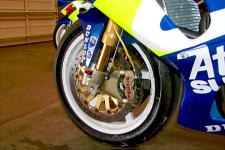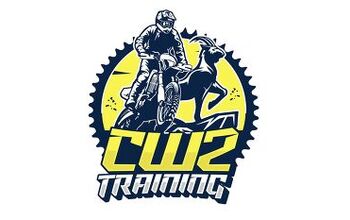Radial-Mount Calipers
What's all the hubbub, Bub?
Lake Elsinore, California, October 9th, 2002 -- Interesting how things that oftentimes appear to be a radical departure from the norm are in fact evolutionary rather than a genuine fundamental revolution. The new buzz on Radial Mount Calipers is straight from the automotive industry with a few minor tweaks. With cars, they've almost always mounted the calipers in a fore and aft manner because it's a straight up simple and strong way to do so. Granted, the new motorcycle version has finally taken that lead and adapted the concept by incorporating a radial mount instead of the commonplace perpendicular (90 degree to rotor face axis) mounting bosses universally prevalent today. In reality, whether calipers are mounted radially or perpendicularly is of little consequence, having only to do with the fact that the new generation calipers can be made a bit lighter via the radial mount set-up (no other significant performance difference here).
I know I'm going to disappoint more than a few technophiles here by stating the Radial Mount design in and of itself offers no real world performance gains beyond improved pad wear characteristics, and that is almost strictly focused on the near elimination of torsional caliper flex. Bear in mind that all conventional calipers are mounted at the trailing edge of the line of force, and that the energy transfer (to the forks) of the braking forces are all focused on just one side of the clamping pressure as applied to the spinning rotor. Then factor in the normal production tolerances between the mounting faces of the rotor/wheel, fork/caliper--plus perpendicular axle alignment within the wheel to these faces, and more.
The relatively new radial mount caliper design virtually eliminates this torsion flex problem since it more efficiently spreads the load both fore and aft to the line of force.
We can stir the pot with greater possibilities for misalignment with (even just slightly) out of true axles and fork tubes. The end result is there's always some degree of mating issues which ultimately affect performance potential yet are still within factory tolerance. Depending on degree of misalignment, a torsional twisting effect of the caliper can come into play during hard braking. This usually manifests itself with radial tapered (bottom to top) pad wear, brake howl and piston retraction problems due to this distortion. The relatively new radial mount caliper design virtually eliminates this torsion flex problem since it more efficiently spreads the load both fore and aft to the line of force. It also offers the additional advantage of better (quicker) release at the end of the braking sequence (brake pad compounds play a large part here, too). Which, from the racing perspective, provides a cleaner transition when braking into the apex on the edge of disaster. This is a very good thing indeed--but something the average weekend warrior will not likely feel at the lever.
As a sidebar, the single-action calipers (live pistons on one side only) such as came on the CBR600F3 (and standard on virtually all motocross bikes) have categorically fallen out of favor for use on sportbikes. This is primarily due to the fact they suffer from unavoidably greater degrees of flex inherent in these calipers' floating pin design and minimal piston area (compared to modern double-action calipers).
The Real World of Greater Performance
Here's where it gets interesting: Incorporated into the design of the new generation Radial Mount Calipers is the latest in braking technology led by two basic concepts. Of course there's more to it than just this, but in an attempt to keep it simple, the elements can be effectively identified by these two separate yet related categories:
Another fundamental and crucial difference is with material and manufacturing techniques. Production machines invariably use mass-produced cast calipers instead of the race-bred gems found in SBK & MotoGP. Those are the real beauties, CNC machined from substantially higher tensile strength billet stock, and often sporting ventilated Titanium pistons. The differences are again manifold but paramount is superior rigidity combined with a typically longer and narrower pad shape. The Narrow Track layout focuses the applied braking pressure over a somewhat smaller area, optimizing [in microseconds] the reaction time of the braking forces. Of course another advantage of the race specific calipers is their lighter weight due in large part again to the higher psi capabilities of the premium grade billet material.
With cost always an issue with production bikes; brake designers went back to the drawing boards to boost performance while keeping a bean counter's check on cost.
Brembo again forged the way forward with the introduction in late 2000 of their stunning Four Pad caliper, which found a home in both the Aprilia Mille and the Ducati 748 and 998 R models. These were the first of their kind to use the individual pad-per-piston design in a mass-produced production caliper. They wisely addressed the performance advantages of increased stiffness with the addition of a massive bridge over the top of the pad cavity opening, greatly increasing resistance to distortion.
2) Pad Design, The Leading Edge The new generation Brembo Four Pad Caliper design was then further enhanced by incorporating four separate pads operating with larger, equal-sized 34mm pistons (than their 30/34mm twin pin forerunner). The necessity of using differential bore piston diameters to reduce pad taper (fore and aft) became a moot point when switching to the short individual pad and piston arrangement.So bottom line, what does it mean to you the sportbike enthusiast and weekend warrior?
Tokico has now taken this concept another step by incorporating a beautifully sculpted individual pad/piston design into the trick looking radial mount system, debuting on the new 2003 Kawasaki ultra ZX6R/RR and Suzuki's revised GSX-R1000 assault weapon.
Does all this new-fangled brake design mean the current crop of high performance calipers are making a quick exodus to the dustbin? Not likely. Need proof? The newly crowned World Superbike Champion of Colin Edwards and the mighty Honda VTR1000Sp2 used the traditional Nissin six-pot billet race caliper all season--Old World perpendicular mount and all. Could it be Honda was too cheap to fork over the cash for the latest radial mount version? Yeah, right! Sure looked to me like the new Champ's brakes were working just fine....
Jeff Gehrs is the man we turn to when news brakes. Bother him at [email protected]More by Jeff Gehrs
































Comments
Join the conversation